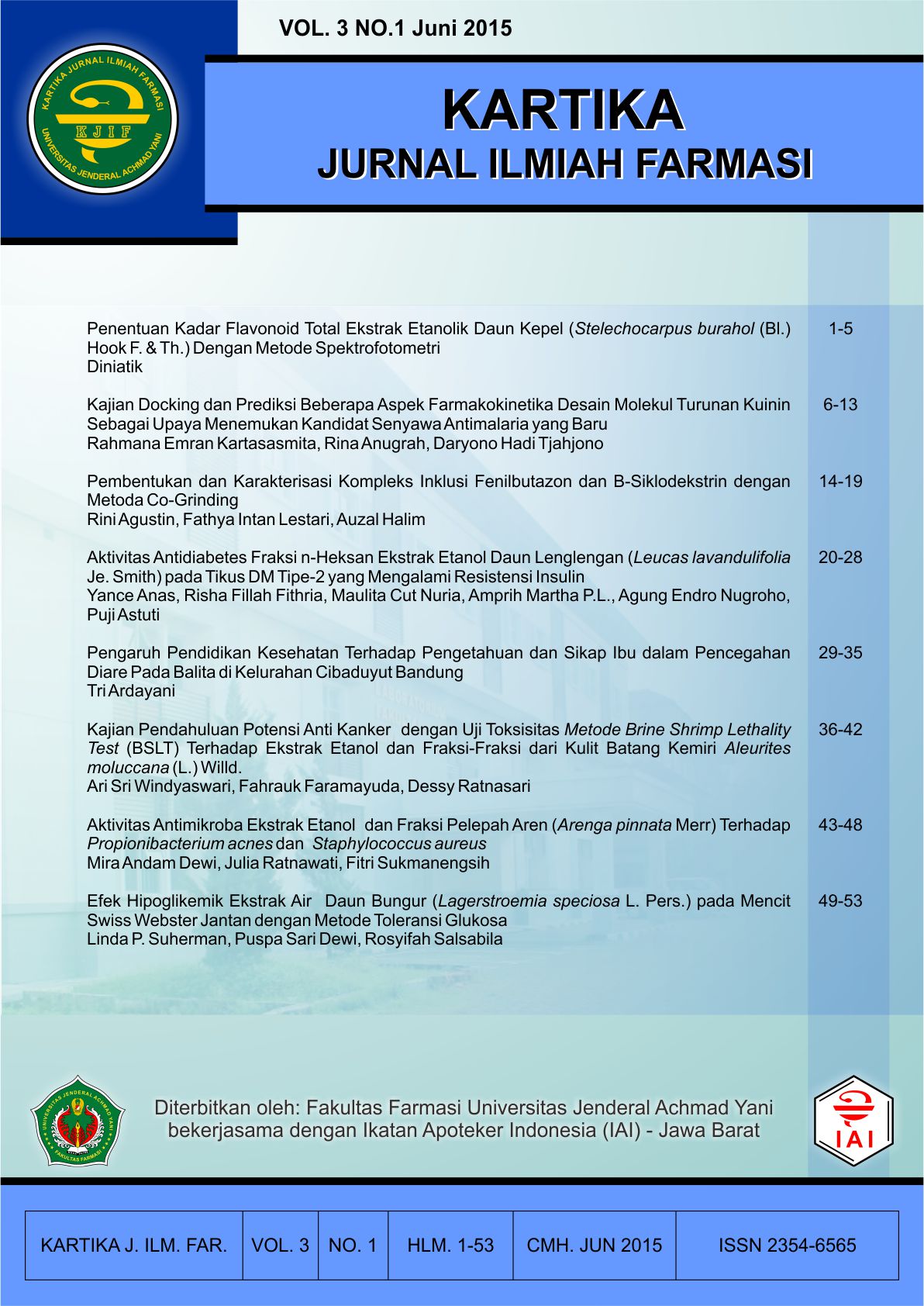KAJIAN DOCKING DAN PREDIKSI BEBERAPA ASPEK FARMAKOKINETIKA DESAIN MOLEKUL TURUNAN KUININ SEBAGAI UPAYA MENEMUKAN KANDIDAT SENYAWA ANTIMALARIA YANG BARU
DOI:
https://doi.org/10.26874/kjif.v3i1.91Abstrak
ABSTRAK
Â
Kuinin merupakan obat antimalaria dengan t½ eliminasi yang panjang, mencapai 11-18 jam, serta memiliki berbagai efek samping yang cukup berat. Dikaitkan dengan struktur dan sifat fisikokimianya, hal tersebut dapat disebabkan tingginya lipofilisitas kuinin dan metabolitnya serta kemungkinan afinitas senyawa tersebut terhadap reseptor tertentu, di luar target kerja pada plasmodium. Penelitian ini bertujuan untuk memperoleh desain turunan kuinin yang memiliki aktivitas antimalaria setara atau lebih baik dari kuinin dengan efek samping yang lebih ringan menggunakan metode molecular modeling, terkhususnya kajian docking antara ligan dengan target. Desain turunan kuinin dilakukan melalui substitusi atom hidrogen pada cincin kuinolin dengan gugus fungsi polar, mencakup gugus -OH, -COOH, dan -SO3H. Ferriprotoporfirin IX digunakan sebagai target kerja antimalaria dan reseptor muskarinik M2 sebagai target kerja lain yang diperkirakan menyebabkan efek samping. Beberapa aspek farmakokinetika desain turunan kuinin yang diperoleh diprediksi secara kualitatif menggunakan aturan Lipinski, dan secara kuantitatif menggunakan program PreADMET, terdiri dari parameter absorpsi, distribusi serta reabsorpsi di ginjal. Telah diperoleh 4 desain senyawa turunan kuinin yang potensial yaitu kuinin tersubstitusi -OH pada atom C7’, kuinin tersubtitusi -COOH pada atom C5’ dan -OH pada atom C6’, kuinin tersubtitusi –SO3H pada atom C8’ serta kuinin tersubtitusi -SO3H pada atom C8’ dan -OH pada atom C6’.
Â
Kata kunci  : antimalaria, docking, ferriprotoporfirin IX, kuinin.
Â
ABSTRACT
Â
Quinine is an antimalarial drug with a long elimination half-life (t ½), about 11-18 hours and variuos severe side effects. Considering the structure and physico-chemical properties of quinine, those side effects and toxicities might be related with high lipophilicity of quinine and its metabolites and their probable affinities on certain receptor in addition to work target in plasmodium. This study aims to obtain designs of quinine derivatives having equivalent or better antimalarial activities with lesser side effects applying molecular modeling method, especially docking study between ligand and target. Quinine derivatives were designed by substitution of hydrogen atoms of different positions in the quinoline ring with three different polar functional groups, including –OH, -COOH, and -SO3H. Ferriprotoporphyrin IX was chosen as work target in plasmodium, while M2 muscarinic receptor was used as additional work target predicted to be responsible for side effects. Pharmacokinetic aspects of quinine derivatives designs were qualitatively predicted by Lipinski’s rules of five and quantitatively by online PreADMET program, including absorption, distribution, and reabsorption in kidney. 4 compound designs were obtained and predicted to be potential candidates, including quinine substituted with -OH at C7' atom, quinine substituted with –COOH at C5’ and –OH at C6’ atoms, quinine substituted with –SO3H at C8’ and quinine substituted with -SO3H at C8’ and –OH at C6’ atoms.
Â
Key words  : antimalarial drug, docking, ferriprotoporphyrin IX, lipophilicity
Referensi
Alkaldi OH, 2007, ‘Antimalarial drug toxicity’, Chemotherapy, Vol.53, pp.385-391.
Alumasa JN, Gorka AP, Casabianca LB, Comstock E, Dios AC, Roepe PD, 2011, ‘The hydroxyl functionality and a rigid proximal N are required for forming a novel non-covalent quinine-heme complex’, J of Inorganics Biochemitry, Vol.105, No.3, pp.467-475.
Brunton LL, 2006, Goodman and Gilman’s the pharmacological basis of therapeutics, 11th Edition, Dalam: Shapiro TA, Goldberg DE, Chemotherapy of protozoal infections, USA: McGraw-Hill Companies Inc, pp.1035-1041.
Egan TJ, 2008, ‘Haemozoin formation’, J Molecular & Biochemical Parasitology, Vol.157, pp.127–136.
Fauci AS, Kasper DL, Longo DL, Loscalzo J, Braunwald E, Hauser SL, Jameson JL, 2008 Horrison’s principle of internal medicine, 17th Edition, Dalam: White NJ, Breman JG, Malaria, USA: McGraw-Hill Companies Inc, pp.1280-1281.
Haga K, Kruse AC, Asada H, Yurugi KT, Shiroishi M, Zhang C, dkk, 2012, ‘Structure of the human M2 muscarinic acetylcholine receptor bound to an antagonist’, Nature, Vol.482, pp.547-551.
Kathreine AV, Marques HM, Egan TJ, 2008, ‘The crystal structure of halofantrine-ferriprotoporphyrin IX and the mechanism of action arylmethanol antimalarials’, J of Inorganics Biochemistry, Vol.102, pp.1660-1667.
Kitchen DB, Decornez H, Furr JR, Bajorath J, 2004, ‘Docking and scoring in virtual screening for drug discovery: methods and applications’, Vol.3, pp.935-949.
Lee SK, Lee IH, Chang GS, Chung JE, No KT, 2003, ‘The preADMET approach : Web-based program for rapid prediction of physico-chemical, drug absorption and drug-like properties’, Blackwell Publising, pp. 418-420.
Lipinski CA, Lombardo F, Dominy BW, Feeney FJ, 2001, ‘Experimental and computational approaches to estimate solubility and permeability in drug discovery and development settings’. Adv. Drug Deliv.Rev, Vol.46 No.1-3, pp.3-26.
Marydele JO, 2001, Merck Index, Thirdteenth Edition, USA: Merck & Co, Inc, pp.8151.
Morris GM, Lim-Wilby M, 2008, Molecular docking, methods in molecular biology, Dalam: Kukol A, Molecular Modeling of Proteins, New Jersey: Humana Press, pp. 365-382.
Trott A.O, J Olson, 2010, ‘AutoDock vina: Improving the speed and accuracy of docking with a new scoring function, efficient optimization and multithreading’, J of Computational Chemistry, Vol.31, pp.455-461.
WHO, 2010, Guidelines for the treatment of malaria, pp.18.
WHO, 2012, World malaria report 2012: Fact Sheet, pp.1-2.
##submission.downloads##
Diterbitkan
Cara Mengutip
Terbitan
Bagian
Lisensi
Penulis yang menerbitkan artikel pada jurnal ini menyetujui ketentuan berikut:
- Penulis memberikan hak cipta dan jaminan atas artikel sebagai publikasi pertama, yang memberikan kesempatan pada orang lain untuk membagi artikel dibawah lisensi Creative Commons Attribution License
- Penulis dapat melakukan perubahan dan menambahkan untuk pendistribusian artikel yang terpublikasi secara non eksklusif (misalnya, mempostingnya ke repositori institusional atau mempublikasikannya dalam sebuah buku), dengan pengakuan publikasi awal dalam jurnal ini.
- Penulis diizinkan dan didorong untuk memposting pekerjaan mereka secara online (misalnya, di repositori institusional atau di situs web mereka) sebelum dan selama proses pengajuan, karena dapat mengarah pada pertukaran produktif, serta kutipan pekerjaan sebelumnya dan lebih besar yang diterbitkan (Lihat The Effect of Open Access).























